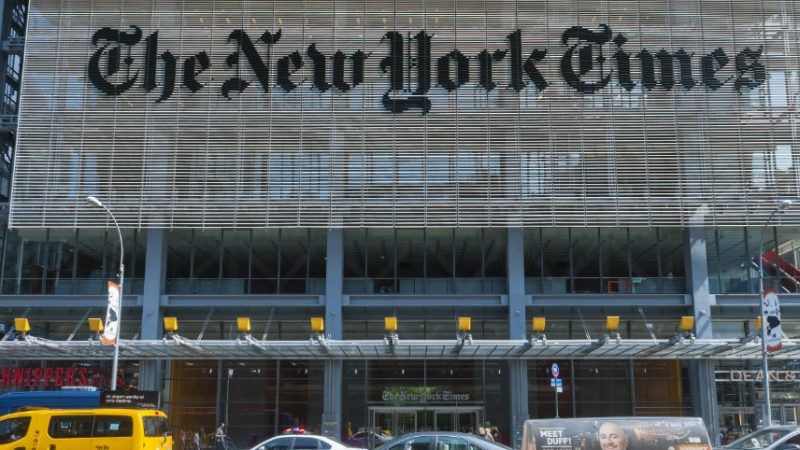Identifying 'Fake News' Is More Art Than Science
The New York Times slams Larry Kudlow for circulating fake news during the 2008 recession, but the Times said the same things at the time.

It's not just President Donald Trump who thinks "fake news" is a problem.
Even The Washington Post's Bob Woodward is warning that some reporters are becoming "emotionally unhinged" covering President Trump and crossing over into a "tone of ridicule."
Science magazine, the peer-reviewed journal whose headlines usually run to "Random heteropolymers preserve protein function in foreign environments" or "Organometallic and radical intermediates reveal mechanism of dipthamide biosynthesis," devoted a recent article to "The science of fake news." It observed that "general trust in the mass media collapsed to historic lows in 2016."
The Science article was by David Lazer of Northeastern University, Matthew Baum of Harvard, and 14 other scholars affiliated with, among other institutions, MIT, Tufts, Indiana University, University of California Santa Barbara, Dartmouth, Yale, Columbia, Brown, and Boston College. They advocated identifying and reacting to "fake news" in part by focusing on the intent of publishers.
That, they write, "allows us to avoid the morass of trying to evaluate the accuracy of every single news story."
With all due respect to the academics, evaluating the accuracy of "every single news story" is precisely the responsibility of every single reader. The alternative—blindly trusting the story, suspending skepticism or independent judgment just because the article confirms your existing point of view, was shared on social media by a friend, or comes from a "credible" news organization—is a kind of infantilization.
To the credit of the academics, they float "empowering individuals" as one possible solution to the "fake news" problem. They mention "education" to "improve individual evaluation of the quality of information sources."
They do, though, worry that "an emphasis on fake news might also have the unintended consequence of reducing the perceived credibility of real-news outlets."
It seems to me that the bigger risk to what the academics credulously call "real-news outlets" is that editors erode a publication's credibility by allowing inaccurate, partisan, fraudulent, or tendentious news to slip through. It's not just the outright hoax-perpetrators such as Janet Cooke at The Washington Post, Stephen Glass at the New Republic, and Jayson Blair at The New York Times. It's also the way bias, double-standards, or sloppiness slip into even run-of-the-mill, routine news coverage.
Take, for example, The New York Times' news article reporting on President Trump's decision to hire Lawrence Kudlow as chairman of the National Economic Council. It devoted three paragraphs to a poll that "found support dipping slightly for Mr. Trump's signature tax law: 49 percent of respondents approved of the bill, down from 51 percent in February."
Given that the poll's margin of sampling error was 1.5%, the idea that a two percentage point move either way is newsworthy is questionable. If the poll had moved two percentage points in the other direction and President Trump tweeted triumphantly about it, you can bet that Times "fact-checkers" would have been all over his case about being statistically illiterate.
The same Times article faulted Kudlow for having been "wildly wrong" by, as the Times put it, "denying the existence of recessions while they were already underway during President George W. Bush's administration."
As an example, the Times quoted Kudlow as writing in December 2007, "Despite all the doom and gloom from the economic pessimistas…the resilient U.S. economy continues moving ahead."
It's not clear to me that Kudlow's December 2007 view qualifies as "wildly wrong." The nonpartisan National Bureau of Economic Research, which has a committee of eminent academic economists that retrospectively dates recessions, describes December 2007 as "the peak of the business cycle," meaning that it was both the "last month" of the expansion and the "first month of the recession." Fourth quarter real GDP growth in 2007 was positive, not negative.
Even if Kudlow was wrong, wildly or less than wildly, in December 2007, he sure had plenty of company. One Times news headline from that month was "Shares Rally on Surprisingly Strong Jobs Data." The lead paragraph of that news article spoke of "renewed optimism about the outlook for the economy." Another Times news headline from that month was "Economy Holding Up, Reports Find." That article began, "Maybe the American economy is not going to keel over just yet, after all. Government reports released Thursday showed surprising resilience in the broader economy."
Attempting to evaluate the accuracy of each individual news story may be a "morass," as the peer-reviewed professors put it. But readers who shirk the task do so at their own peril.
Ira Stoll is editor of FutureOfCapitalism.com and author of JFK, Conservative.


Show Comments (30)